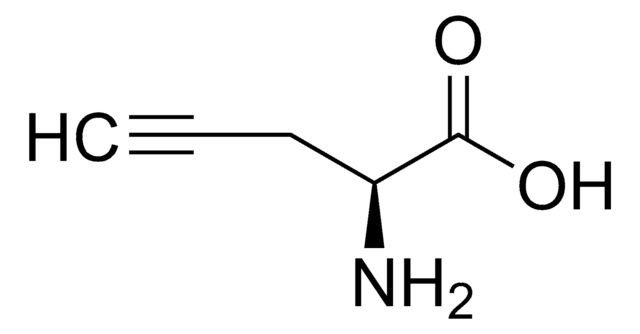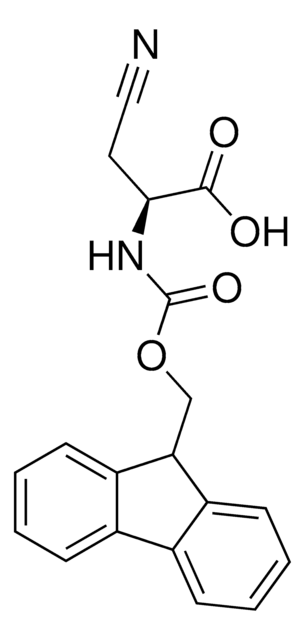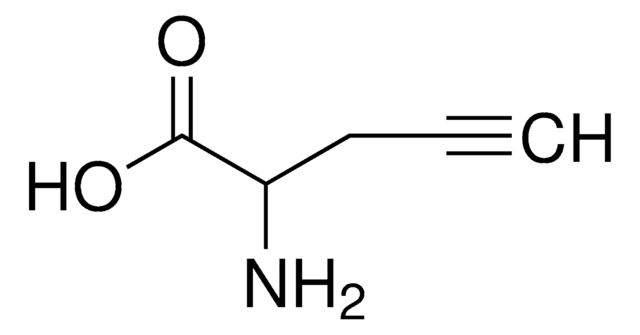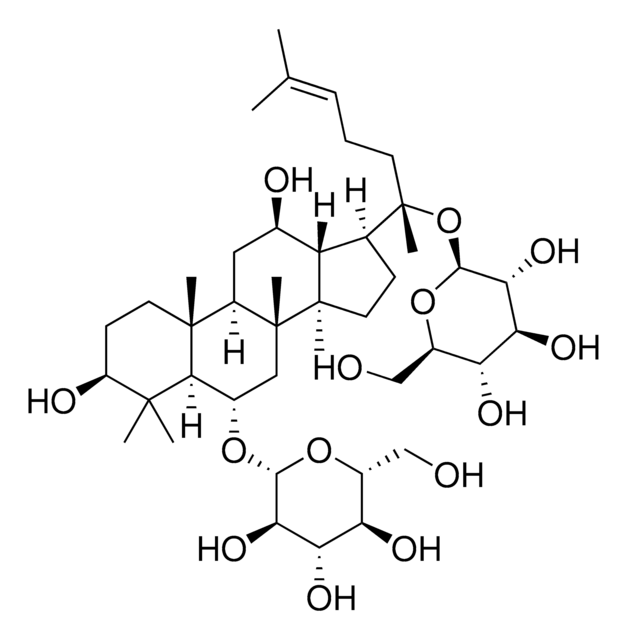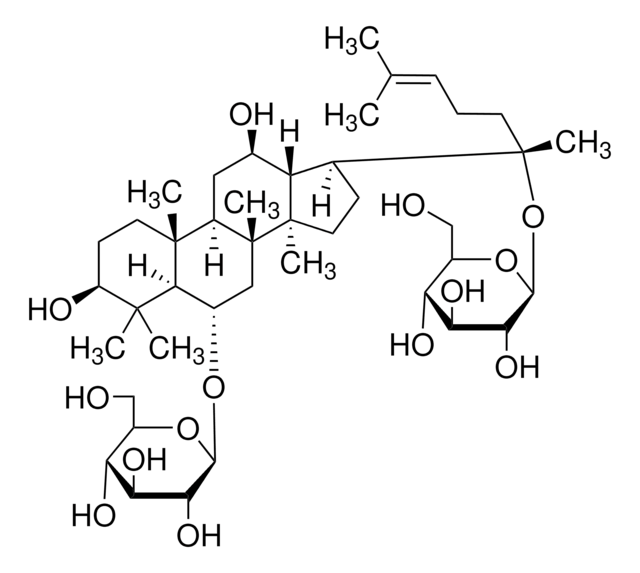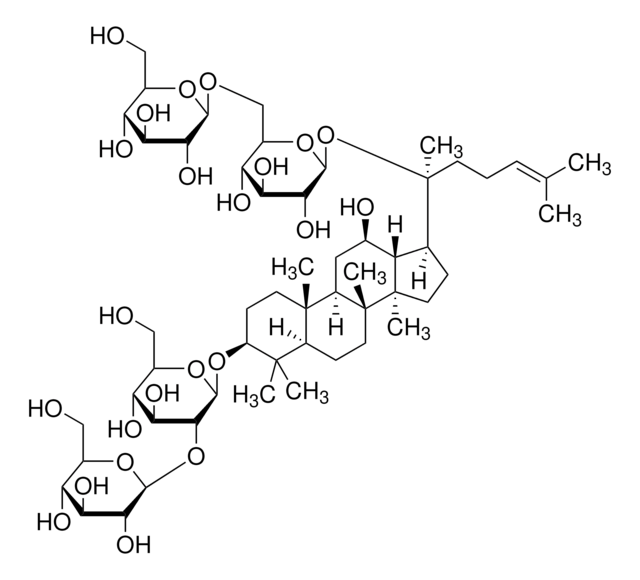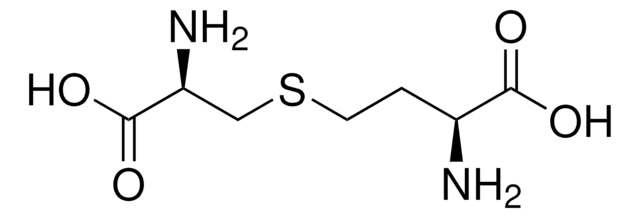Alle Fotos(1)
Wichtige Dokumente
C9650
β-Cyan-L-alanin
≥95%, suitable for ligand binding assays
Synonym(e):
3-cyano-L-alanine
Anmeldenzur Ansicht organisationsspezifischer und vertraglich vereinbarter Preise
Alle Fotos(1)
About This Item
Empirische Formel (Hill-System):
C4H6N2O2
CAS-Nummer:
Molekulargewicht:
114.10
MDL-Nummer:
UNSPSC-Code:
12352209
PubChem Substanz-ID:
NACRES:
NA.26
Empfohlene Produkte
Produktbezeichnung
β-Cyan-L-alanin, ≥95%
Qualitätsniveau
Assay
≥95%
Form
powder
Methode(n)
ligand binding assay: suitable
Farbe
white
mp (Schmelzpunkt)
217 °C
Lagertemp.
−20°C
SMILES String
OC([C@@H](N)CC#N)=O
InChI
1S/C4H6N2O2/c5-2-1-3(6)4(7)8/h3H,1,6H2,(H,7,8)/t3-/m0/s1
InChIKey
BXRLWGXPSRYJDZ-VKHMYHEASA-N
Suchen Sie nach ähnlichen Produkten? Aufrufen Leitfaden zum Produktvergleich
Biochem./physiol. Wirkung
β-Cyano-L-alanine (BCA) is used as a cystathione γ-lyase (CSE) inhibitor to study the physiological roles of hydrogen sulfide in processes such as angiogenesis and hypertension.
Lagerklassenschlüssel
11 - Combustible Solids
WGK
WGK 3
Flammpunkt (°F)
Not applicable
Flammpunkt (°C)
Not applicable
Hier finden Sie alle aktuellen Versionen:
Besitzen Sie dieses Produkt bereits?
In der Dokumentenbibliothek finden Sie die Dokumentation zu den Produkten, die Sie kürzlich erworben haben.
Andrew G S Warrilow et al.
Journal of experimental botany, 53(368), 439-445 (2002-02-16)
The reaction mechanisms of three enzymes belonging to a single gene family are compared: a cyanoalanine synthase and two isoforms of O-acetylserine (thiol) lyase (O-ASTL) isolated from spinach (Spinacea oleracea L. cv. Medina). O-ASTL represents a major regulatory point in
Markus Piotrowski et al.
Plant molecular biology, 61(1-2), 111-122 (2006-06-21)
Cyanoalanine hydratase (E.C. 4.2.1.65) is an enzyme involved in the cyanide detoxification pathway of higher plants and catalyzes the hydrolysis of beta-cyano-L-alanine to asparagine. We have isolated the enzyme from seedlings of blue lupine (Lupinus angustifolius) to obtain protein sequence
B Teague et al.
British journal of pharmacology, 137(2), 139-145 (2002-09-05)
1. Sodium hydrogen sulphide (NaHS), a donor of hydrogen sulphide (H(2)S), produced dose-related relaxation of the rabbit isolated ileum (EC(50), 76.4+/-7.9 microM) and rat vas deferens (EC(50), 64.8+/-5.4 microM) and reduced ACh-mediated contraction of the guinea-pig isolated ileum. 2. NaHS
Mariarosaria Bucci et al.
Arteriosclerosis, thrombosis, and vascular biology, 30(10), 1998-2004 (2010-07-17)
Recent studies have demonstrated that hydrogen sulfide (H(2)S) is produced within the vessel wall from L-cysteine regulating several aspects of vascular homeostasis. H(2)S generated from cystathione γ-lyase (CSE) contributes to vascular tone; however, the molecular mechanisms underlying the vasorelaxing effects
M Piotrowski et al.
The Journal of biological chemistry, 276(4), 2616-2621 (2000-11-04)
Nitrilases (nitrile aminohydrolases, EC ) are enzymes that catalyze the hydrolysis of nitriles to the corresponding carbon acids. Among the four known nitrilases of Arabidopsis thaliana, the isoform NIT4 is the most divergent one, and homologs of NIT4 are also
Unser Team von Wissenschaftlern verfügt über Erfahrung in allen Forschungsbereichen einschließlich Life Science, Materialwissenschaften, chemischer Synthese, Chromatographie, Analytik und vielen mehr..
Setzen Sie sich mit dem technischen Dienst in Verbindung.